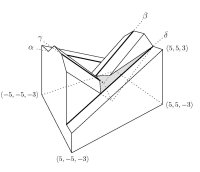This is a followup to Bill Thurston's question about different notions of hulls. Here I want to raise a question about the reflex-free hull, which is, intuitively, the smallest enclosing shape to an object that cannot hold water in any orientation. Let $S$ be a closed solid object in $\mathbb{R}^3$, and $\partial S$ its surface. Let $H$ be a closed hemispherical neighborhood, a ball intersected with a closed halfspace through its center. Define a reflex point $p$ on $\partial S$ to be one such that it has a neighborhood $H$ such that (a) $H \subset S$ and (b) $H \cap \partial S = p$. An object is reflex-free if it has no reflex points. Intuitively, a reflex point could hold a drop of water in its exterior neighborhood in some orientation. For example, this shape is reflex-free:
![Shape][2]
The reflex-free hull of an object $O$ is the intersection of all reflex-free shapes that enclose $O$. This notion was introduced in the interesting paper cited below. It has application to manufacturing by molten-metal casting, and applications to architecture.They established a number of properties of the reflex-free hull, but could not find an algorithm to construct it.
Q1. Provide a finite algorithm to construct the reflex-free hull for a polyhedron.
They identified a number of difficulties that various ideas
for algorithms would encounter.
An algorithm that fills in cavities naively,
approaches, but never reaches, the reflex-free hull
of this example (their Fig. 7):

Q2. Is the reflex-free hull the same as Thurston's "knife hull"? (Answered by Bill Thurston below: No.)
Reference. Hee-kap Ahn, Siu-Wing Cheng, Otfried Cheong, Jack Snoeyink. "The Reflex-Free Hull." In Proc. 13th Canadian Conference on Computational Geometry, 2001, and in International Journal of Computational Geometry and Applications, 14(6):453-474, 2004. (CiteSeer link).
